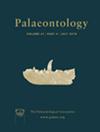求助PDF
{"title":"我相信我能飞......基于晚三叠世 Ozimek volans 独特的长骨组织学对其生活方式和古生态学的新启示","authors":"Dorota Konietzko‐Meier, Elżbieta M. Teschner, Agnieszka Tańczuk, P. Martin Sander","doi":"10.1111/pala.12715","DOIUrl":null,"url":null,"abstract":"The small diapsid reptile <jats:italic>Ozimek volans</jats:italic> is one of the most enigmatic representatives of the Late Triassic fauna of Krasiejów, Poland. Phylogenetically, <jats:italic>Ozimek</jats:italic> was identified as a ‘protorosaurian’ related to tanystropheids, but the extremely elongated limbs and presumed gliding abilities are unusual for this group. This raises the question of whether the lifestyle inferred for this taxon is reflected in its bone histology.Two long bones from a single bone association of <jats:italic>Ozimek</jats:italic> (humerus UOPB 1148a and femur UOPB 1148b) were sectioned at the midshaft to obtain details of the histological framework. A large medullary cavity, thin walls of lamellar bone with numerous lamellae, and only very few simple vascular canals are shared by both bones. Application of a modified 3‐front model (introducing a fourth front) of cortical growth reveals that the femur is ontogenetically younger when compared to the humerus.<jats:italic>Ozimek</jats:italic> limb bones, with their small diameter, compact structure, low vascularization, no remodelling, and a lack of pneumaticity, are histologically similar to those of modern small bats. The characteristic cortex of both may have been well suited to withstand high loads while limiting weight. The well‐ordered collagen fibres in successive lamellae along the bone may be a key adaptation for the better distribution of the load generated during gliding. © 2024 The Palaeontological Association.","PeriodicalId":56272,"journal":{"name":"Palaeontology","volume":"3 1","pages":""},"PeriodicalIF":2.5000,"publicationDate":"2024-06-26","publicationTypes":"Journal Article","fieldsOfStudy":null,"isOpenAccess":false,"openAccessPdf":"","citationCount":"0","resultStr":"{\"title\":\"I believe I can fly… New implications for the mode of life and palaeoecology of the Late Triassic Ozimek volans based on its unique long bone histology\",\"authors\":\"Dorota Konietzko‐Meier, Elżbieta M. Teschner, Agnieszka Tańczuk, P. Martin Sander\",\"doi\":\"10.1111/pala.12715\",\"DOIUrl\":null,\"url\":null,\"abstract\":\"The small diapsid reptile <jats:italic>Ozimek volans</jats:italic> is one of the most enigmatic representatives of the Late Triassic fauna of Krasiejów, Poland. Phylogenetically, <jats:italic>Ozimek</jats:italic> was identified as a ‘protorosaurian’ related to tanystropheids, but the extremely elongated limbs and presumed gliding abilities are unusual for this group. This raises the question of whether the lifestyle inferred for this taxon is reflected in its bone histology.Two long bones from a single bone association of <jats:italic>Ozimek</jats:italic> (humerus UOPB 1148a and femur UOPB 1148b) were sectioned at the midshaft to obtain details of the histological framework. A large medullary cavity, thin walls of lamellar bone with numerous lamellae, and only very few simple vascular canals are shared by both bones. Application of a modified 3‐front model (introducing a fourth front) of cortical growth reveals that the femur is ontogenetically younger when compared to the humerus.<jats:italic>Ozimek</jats:italic> limb bones, with their small diameter, compact structure, low vascularization, no remodelling, and a lack of pneumaticity, are histologically similar to those of modern small bats. The characteristic cortex of both may have been well suited to withstand high loads while limiting weight. The well‐ordered collagen fibres in successive lamellae along the bone may be a key adaptation for the better distribution of the load generated during gliding. © 2024 The Palaeontological Association.\",\"PeriodicalId\":56272,\"journal\":{\"name\":\"Palaeontology\",\"volume\":\"3 1\",\"pages\":\"\"},\"PeriodicalIF\":2.5000,\"publicationDate\":\"2024-06-26\",\"publicationTypes\":\"Journal Article\",\"fieldsOfStudy\":null,\"isOpenAccess\":false,\"openAccessPdf\":\"\",\"citationCount\":\"0\",\"resultStr\":null,\"platform\":\"Semanticscholar\",\"paperid\":null,\"PeriodicalName\":\"Palaeontology\",\"FirstCategoryId\":\"89\",\"ListUrlMain\":\"https://doi.org/10.1111/pala.12715\",\"RegionNum\":2,\"RegionCategory\":\"地球科学\",\"ArticlePicture\":[],\"TitleCN\":null,\"AbstractTextCN\":null,\"PMCID\":null,\"EPubDate\":\"\",\"PubModel\":\"\",\"JCR\":\"Q1\",\"JCRName\":\"PALEONTOLOGY\",\"Score\":null,\"Total\":0}","platform":"Semanticscholar","paperid":null,"PeriodicalName":"Palaeontology","FirstCategoryId":"89","ListUrlMain":"https://doi.org/10.1111/pala.12715","RegionNum":2,"RegionCategory":"地球科学","ArticlePicture":[],"TitleCN":null,"AbstractTextCN":null,"PMCID":null,"EPubDate":"","PubModel":"","JCR":"Q1","JCRName":"PALEONTOLOGY","Score":null,"Total":0}
引用次数: 0
引用
批量引用
I believe I can fly… New implications for the mode of life and palaeoecology of the Late Triassic Ozimek volans based on its unique long bone histology
The small diapsid reptile Ozimek volans is one of the most enigmatic representatives of the Late Triassic fauna of Krasiejów, Poland. Phylogenetically, Ozimek was identified as a ‘protorosaurian’ related to tanystropheids, but the extremely elongated limbs and presumed gliding abilities are unusual for this group. This raises the question of whether the lifestyle inferred for this taxon is reflected in its bone histology.Two long bones from a single bone association of Ozimek (humerus UOPB 1148a and femur UOPB 1148b) were sectioned at the midshaft to obtain details of the histological framework. A large medullary cavity, thin walls of lamellar bone with numerous lamellae, and only very few simple vascular canals are shared by both bones. Application of a modified 3‐front model (introducing a fourth front) of cortical growth reveals that the femur is ontogenetically younger when compared to the humerus.Ozimek limb bones, with their small diameter, compact structure, low vascularization, no remodelling, and a lack of pneumaticity, are histologically similar to those of modern small bats. The characteristic cortex of both may have been well suited to withstand high loads while limiting weight. The well‐ordered collagen fibres in successive lamellae along the bone may be a key adaptation for the better distribution of the load generated during gliding. © 2024 The Palaeontological Association.


